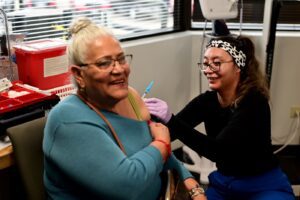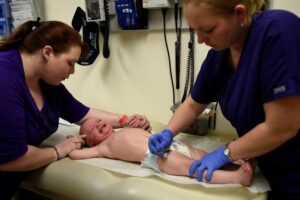When the COVID-19 pandemic hit, ophthalmology clinics, like other establishments, had to adapt. This is particularly true in the case of urgent and emergent ocular referrals. Although many of these calls do result in cases that require immediate medical attention, remotely triaging these patients appropriately can cut down on unnecessary risk.
Because of the pandemic, “health care has been disrupted on 2 fronts: the direct effect of COVID-19 on health care, and the indirect effects that arise from mitigating efforts,” explains an article published in The Lancet.1 “In general, health-care systems had to reorganize care for existing patients to reduce face-to-face clinic appointments, triage cases requiring urgent consultation, postpone nonurgent visits including elective surgeries, and set up new infection control measures.”1
Even without a pandemic threat driving these changes, ophthalmology has been developing the tools and the training to better guide which patients should immediately present to the office and which to schedule for an appointment within the next few days. Referral centers, also known as tertiary care hospitals, have been building this capability for years. As the hubs of the so-called hub-and-spoke model of clinical services, they’re already accustomed to applying a telemedical approach to patients in geographically remote settings.1
Continue Reading
Here, we review the technologies making this type of patient care possible, examine best practices, and consider what aspects of these pandemic-era methods are likely to be kept around permanently.
The Right People, The Right Technologies
Though it’s clear the pandemic has negatively impacted many aspects of life and work for everyone, some adaptations made during the last year in the medical field may be here to stay due to the efficiency they bring to certain procedures.
Remote triaging, often done by telephone, is a measure that was already in place for many facilities, but it became incredibly important to perform with accuracy during the pandemic. One facility that has prioritized efficacy in triaging is the Wills Eye Hospital Emergency Department (ED) in Philadelphia. A review published in Ophthalmology shows, the triaging ophthalmologists at Wills were able to correctly diagnose 69.9% of conditions over the phone from referring providers who may not have the advanced resources required to examine a patient with an ocular emergency in-depth.2
Not all facilities prioritize ophthalmology so highly. As a result, they risk offering patients less-than-optimum care. The key element, the Wills study suggests, is the presence of a triaging ophthalmologist or optometrist. “Eye specialists (ophthalmologists, optometrists, and unknown) made the correct referring diagnosis in significantly more cases (77.8% [91/117]) than non-eye specialists (57.4% [112/195]),” the study shows.
While the pandemic forced clinicians to establish a remote triaging protocol quickly, some of the tools already available are now providing opportunities to connect patients with specialized care. For instance, the lead author of the Wills study, Jordan Deaner, MD, a vitreoretinal surgeon with Duke University Eye Center, says technology such as wide-field imaging devices, while they may not be capable of standing in for a comprehensive dilated fundus exam, “certainly offer a ton to glean, especially when you begin to combine it with fundus autofluorescence, and wide-field fluorescein angiography, and wide-field optical coherence tomography (OCT).”
These kinds of devices could, potentially, be installed at local optometry or general practitioners’ offices, and specialists could remotely consult with the local provider or advise on whether the patient needs to be seen by a surgeon. This kind of application can bring specialized skills to more rural or remote areas. Although, getting these technologies where they need to be to achieve this will require some updates. “Miniaturization of our technologies [the wide-field imaging and OCT devices, specifically] and price-scaling is going to be the limiting factor.”
Don’t Miss These “Can’t-Misses”
When the pandemic started, “all of the sudden we were all thrust into this situation where, unless you were having something like acute vision loss or were in a life-threatening situation, we weren’t going to bring you into the office,” Dr Deaner recalls. While practices are beyond that initial phase of the pandemic, identifying those “red flags” is going to remain critical in any remote-triaging protocol.
Dr Deaner’s research makes an important distinction between less-threatening disorders, such as an uncomplicated corneal abrasion, and “can’t miss” diagnoses, which were defined as conditions that could cause irreversible vision loss or death if not treated emergently. “Any sort of projectile injury raises a flag in my mind,” he explains. Also, headaches combined with weight loss and fever could all be indicators of another can’t-miss condition, giant cell arteritis. Additionally, “nausea, vomiting, blurred vision and halos around things” all qualify as red flags for angle closure glaucoma, he explains. Additional can’t-miss diagnoses, as outlined by the research, include cerebrovascular accident, ruptured globe, orbital compartment syndrome, central nervous system lesion, third-nerve palsy, acute Horner’s syndrome, and endophthalmitis.2
In one case he outlined an “ED provider said ‘oh, we have this strange patient, who has a remote history of trauma, but they’re now having episodes of vision loss that are lasting 1 to 5 minutes and it’s just 1 eye and it comes and goes. We don’t think it’s that serious.’ Well, any ophthalmologist will recognize that as a transient ischemic attack. That’s a precursor to a stroke.”
These are techniques that Virginia Eye Consultants optometrist Cecilia Koetting, OD, FAAO, has also honed. Virginia Eye Consultants, a tertiary care center that offers both ophthalmic and optometric services, has been back to 95% in-person capacity since June. Her team has long featured allied health professionals who triage via telehealth. The decisions that her team makes have been even more crucial since the onset of the pandemic. In fact, Dr Koetting presented on her facility’s approach to remote triaging at the 2020 Southeastern Educational Congress of Optometry (SECO) meeting.
Since the pandemic, she’s started getting directly involved in the triaging process. Especially for cases that are “kind of on the borderline,” Dr Koetting says. In the past, a physician might not have intervened. Now, with capabilities such as video conferencing becoming more popularized, her approach is to tell the patient “you may have just a subconjunctival hemorrhage, but let me get on the phone with you” to help understand if there’s a chance of anything else at play.
Know The Limits
Despite the convenience of remote triaging, Dr Koetting recognizes that no technology can replace a comprehensive in-person exam. Certain signs and symptoms can be identical for certain disorders and need to be investigated more closely to make the correct diagnosis, she warns.
“Taking the time to do a really detailed exam and a detailed history can make the difference between one diagnosis and another,” Dr Koetting says. “If I have a patient who is coming in with viral conjunctivitis and I look but I don’t flip the lid, I might just say, ‘Oh, you’ve probably got allergies.’ That would completely change how I treat the patient. It would be a difference in the patient being contagious vs not contagious.”
In addition to concerns of accurate diagnosis in a remote evaluation, Dr Koetting says that expecting patients to have the technological proficiency necessary to use required software is not always realistic.
“I still have some patients who don’t have cell phones who live in more rural areas, and some who have a flip phone, so there’s still the technology issue there,” Dr Koetting says. “When I was doing exams, I was doing Doxy.me as my platform because it sent a link to my patient and they didn’t have to download anything. They could just get on. It just made it a lot easier, especially with the older patients.”
However, in these pandemic times, eye specialists have been making do with the information they can get while patients are at home — and as it turns out, it isn’t as limited as one might expect. Clinicians may just have to get creative.
“You’re using points of reference that are different than what we normally would, but you can still get a lot of the same entrance exam findings that you may even if they were in your office,” she says. “Confrontation fields you can’t do, but you can at least do EOMs, look at patients’ pupils and get a good overall sense of how they’re doing. Even checking vision is possible: you can say, ‘OK, can you read the words on the TV across the room? Great, is that the same that you could see days ago? Can you see me on your phone now?’”
One tool might make this particular aspect of a remote exam a little easier. A 2021 JAMA Ophthalmology study found that a printable home visual acuity (VA) exam — developed by a Moorfields Eye Hospital team — has relatively high test-retest repeatability and agreement in the visual impairment category.3 The research team supports its adoption as a first step in remote triaging. Because this test employs printouts, it is able to avoid the challenges associated with video and telephone-based acuity measurements. “Computer-based assessments of VA require careful calibration of viewing distance, screen size, and screen luminance,” the study explains.3
Prepare to Partner With Artificial Intelligence
Dr Koetting says that the future of certain aspects of triaging is in technology, as it is only optimizing with time. “Artificial intelligence (AI) is now being utilized by some VAs and hospitals to take retinal photos and then assess patients for any signs of diabetic retinopathy, looking for hemorrhaging,” Dr Koetting says.
Dr Deaner believes that, one day, perhaps, a combined imaging device could help patients obtain OCT, fundus autofluorescence, and wide-field fundus images and use AI to categorize the patient as potentially at risk for disease. “AI is going to have a huge role in screening patients moving forward,” Dr Deaner says. He imagines a day when you can stop into a primary care facility, or perhaps even an unmanned imaging station that “takes the picture, creates a fundus autofluorescence, creates an OCT, and tells the patient they may be at risk for macular degeneration. Then, it spits out a referral number to the closest ophthalmologist’s office to their home address.”
Although the field may not be ready for a complete switch to remote triaging, the advances and adaptations made in eye care during the last year represent a major step forward for the field. Ophthalmologists, optometrists and researchers in eye care have all taken the COVID-19 crisis and created opportunities to expand the reach of the top quality care these clinicians and their technologies can offer.
References
1. Gunasekeran D, Tham Y, Ting D, Tan G, Wong T. Digital health during COVID-19: lessons from operationalising new models of care in ophthalmology. Lancet Digit Health. 2021;3(2):e124-e134. doi:10.1016/S2589-7500(20)30287-9.
2. Deaner J, Amarasekera D, Ozzello D, et al. Accuracy of referral and phone-triage diagnoses in an eye emergency department. Ophthalmol. 2021;128(3):471-473. doi:10.1016/j.ophtha.2020.07.040.
3. Crossland M, Dekker T, Hancox J. Evaluation of a home-printable vision screening test for telemedicine. JAMA Ophthalmol. 2021;139(3):271-277. Doi: 10.1001/jamaophthalmol.2020.5972.
This article originally appeared on Ophthalmology Advisor





